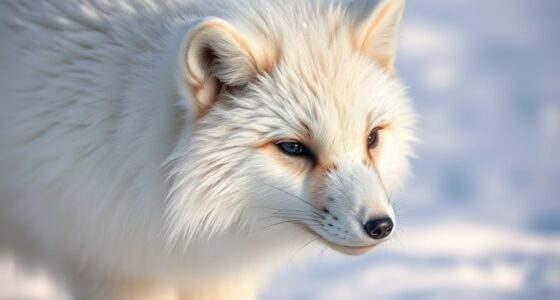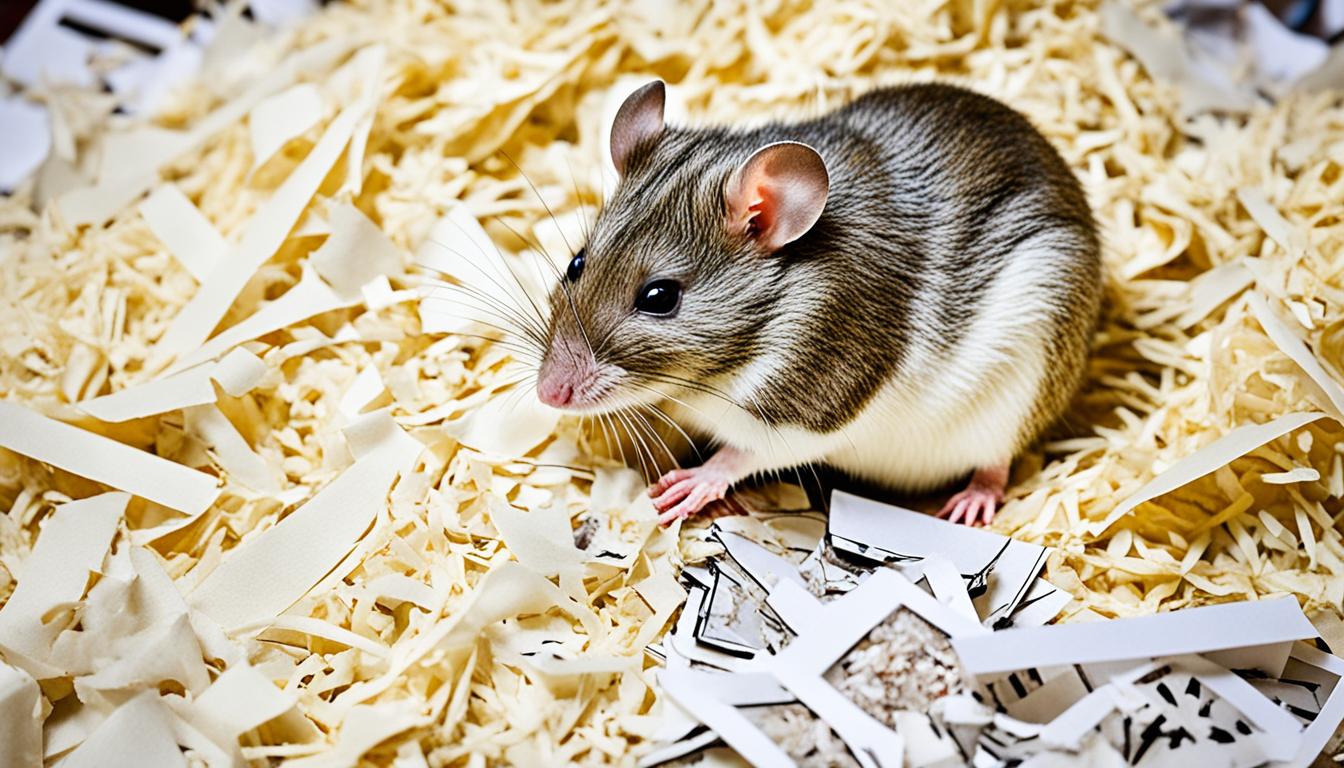Octopuses have some curious habits that showcase their intelligence and adaptability. They inhabit diverse marine environments and display remarkable problem-solving skills, often using tools. Their camouflaging abilities, thanks to chromatophores, allow rapid color and texture changes for communication and hunting. Octopuses can move swiftly through jet propulsion and exhibit social behaviors, like shoaling with fish when isolated. With such fascinating traits, you'll find even more intriguing aspects of their lives waiting for you to uncover.
Key Takeaways
- Octopuses exhibit problem-solving skills and tool use, showcasing their adaptability and intelligence in various environments.
- Their advanced camouflage abilities allow them to rapidly change color and texture for communication and hiding from predators.
- With a high brain-to-body-mass ratio, octopuses have complex nervous systems that contribute to their remarkable sensory perception and independent arm movement.
- Female octopuses display significant parental investment, guarding and cleaning thousands of eggs until they hatch, after which they enter a phase of senescence.
- Octopuses are known to exhibit social behaviors, such as shoaling with fish, especially when isolated or threatened.
Distribution

Octopuses thrive in diverse marine environments, found in all the world's oceans. They inhabit a large range of depths, from shallow coastal areas to the deep sea, including the abyssal plains and even hadal zones.
While octopuses can't tolerate freshwater, some species adapt to brackish water. You'll notice that diversity peaks near the equator, with about 40 species at latitudes around 11°N, while only around 5 species exist at higher latitudes like 60°N.
These fascinating creatures can endure low temperatures and rapidly changing conditions, showcasing their adaptability. With an estimated 800 living cephalopod species, octopuses represent a significant part of this diversity, reflecting their long history dating back to the Cambrian period.
Biology
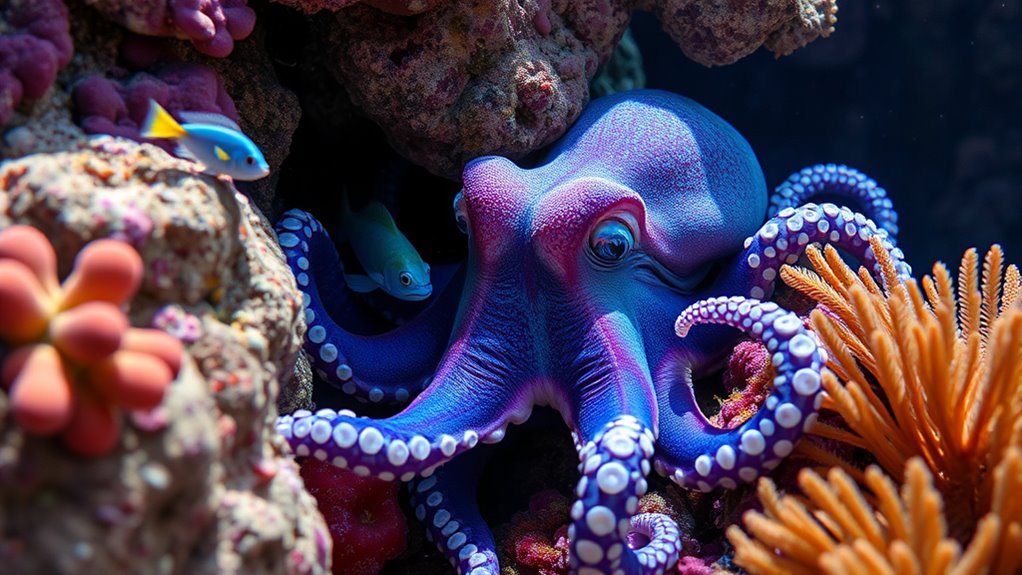
While exploring the biology of these remarkable creatures, you'll find that octopuses exhibit a range of fascinating adaptations that contribute to their survival and intelligence. Their complex nervous system and impressive brain-to-body-mass ratio make them highly intelligent. They possess a closed circulatory system featuring two gill hearts and a systemic heart, ensuring efficient oxygen transport. Their chromatophores enable rapid color and texture changes, essential for camouflage and communication. Additionally, their unique eyes provide acute vision without a cornea. Unlike most molluscs, octopuses use jet propulsion for swift movements and can release ink clouds to confuse predators.
| Adaptation | Function | Importance |
|---|---|---|
| Complex Nervous System | High intelligence | Problem-solving abilities |
| Closed Circulatory System | Efficient oxygen transport | Sustains energy levels |
| Chromatophores | Camouflage and communication | Predator evasion |
| Unique Eyes | Acute vision | Environmental awareness |
| Jet Propulsion | Rapid movement | Escape from threats |
Nervous System and Behavior
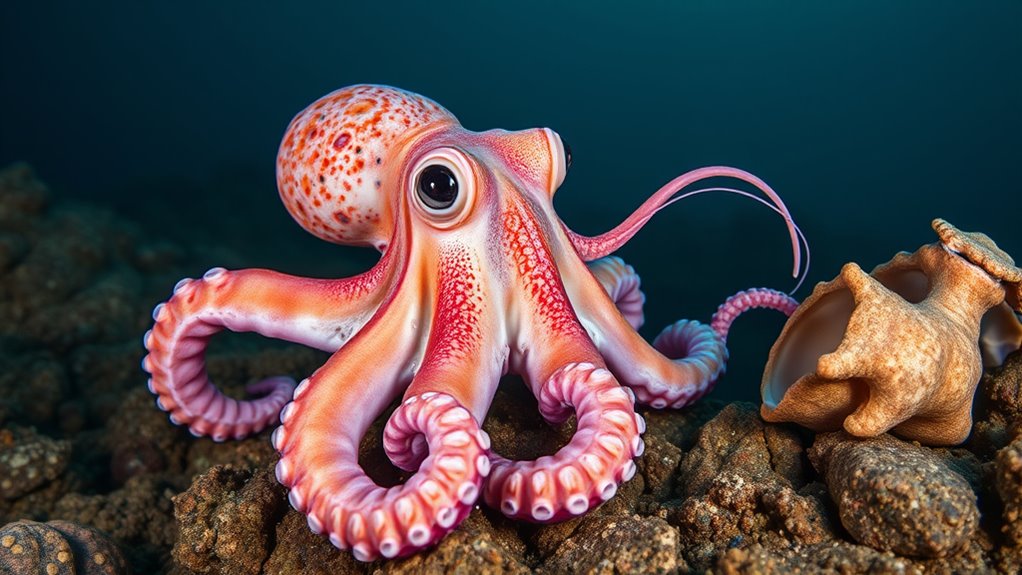
Understanding the nervous system of octopuses reveals just how remarkable their behavior can be. With a brain-to-body-mass ratio that sits between warm-blooded and cold-blooded vertebrates, these creatures exhibit high intelligence and cognitive abilities.
About two-thirds of their neurons reside in their arms, allowing them to move and sense independently of their central brain. You'll find them solving problems and using tools, showcasing their adaptability in diverse environments.
With two-thirds of their neurons in their arms, octopuses can move and sense independently, demonstrating remarkable problem-solving skills and adaptability.
Their extraordinary camouflage skills let them change skin color and texture in milliseconds, controlled by complex neural pathways. Additionally, octopuses display social behaviors, like shoaling with fish when isolated, hinting at a social side not often seen in solitary invertebrates.
Their nervous system truly underpins their fascinating behaviors.
Senses
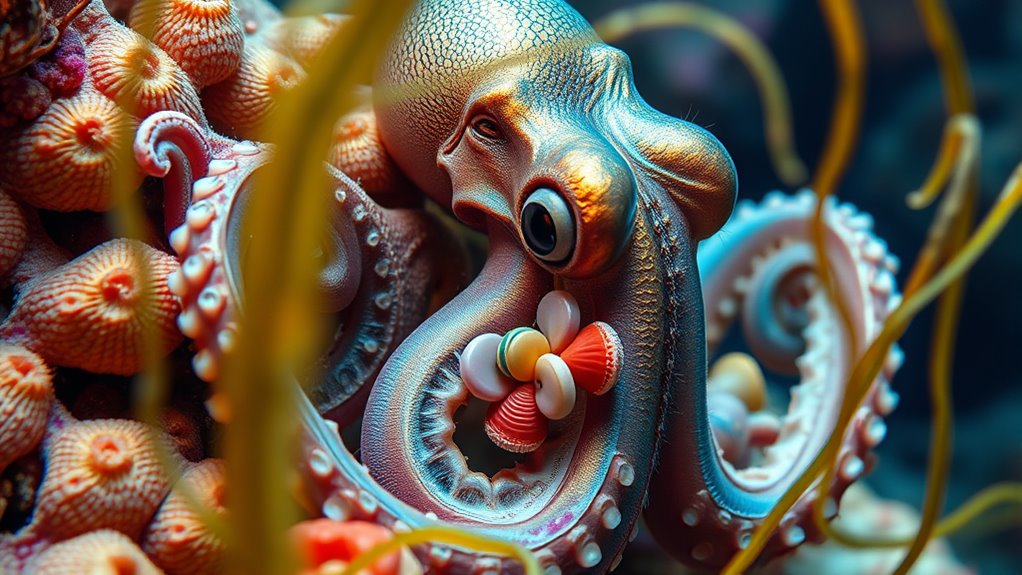
Octopuses have some of the most advanced vision in the animal kingdom, allowing you to see a world rich in detail.
Their unique touch sensation adds another layer to their perception, as they explore their surroundings with incredible dexterity.
Together, these senses make octopuses fascinating creatures, fully aware of their environment.
Advanced Vision Capabilities
How do octopuses navigate their underwater world with such precision? These fascinating creatures rely on their advanced vision, finely tuned to detect brightness, size, shape, and orientation. Their unique eye structure, with an everted retina and distinctive pupil shapes, allows them to excel in light processing. Furthermore, they might even enjoy color vision due to multiple photoreceptors.
| Feature | Description |
|---|---|
| Eye Structure | Everted retina, no cornea |
| Depth Perception | Utilizes arms for exploration |
| Light Processing | Unique pupil shapes |
| Color Vision | Evidence of multiple photoreceptors |
These adaptations guarantee octopuses can efficiently interact with their vibrant underwater environments.
Unique Touch Sensation
While exploring their underwater domain, octopuses rely heavily on their remarkable sense of touch, which allows them to navigate and interact with their environment effectively.
Their arms are lined with sensitive suckers, each containing about 10,000 sensory receptors that detect texture and chemical cues. This incredible ability lets you see how octopuses manipulate objects with impressive precision and dexterity.
You'll find it fascinating that they can taste through their suckers, helping them identify edible prey while foraging. Additionally, they exhibit tactile learning, adapting their behavior based on the textures and shapes they encounter.
This unique sensation compensates for their relatively poor vision in murky waters, enhancing their hunting skills and interactions in their vibrant underwater world.
Use of Light
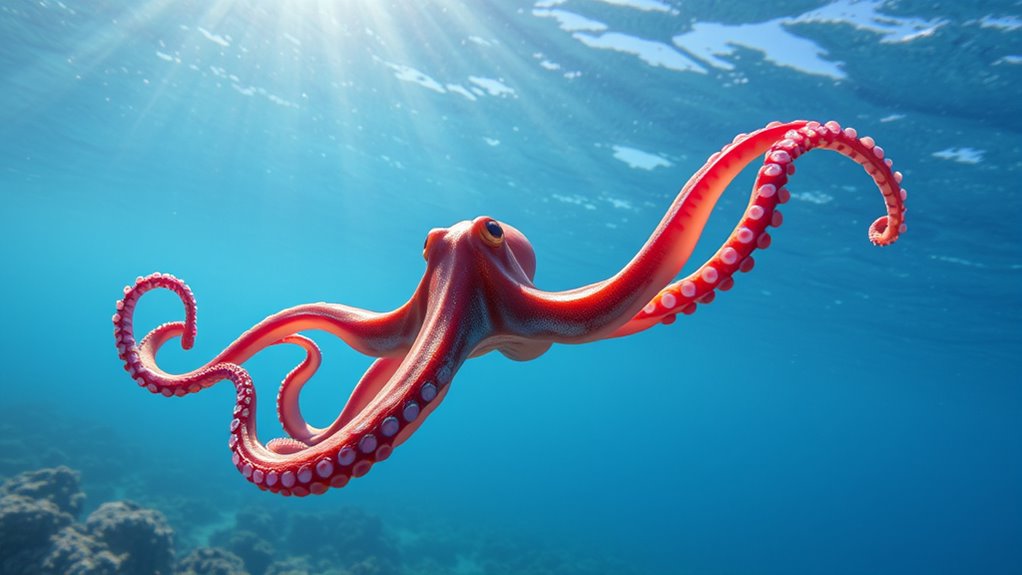
When you think about octopuses, their incredible use of light really stands out.
They not only have advanced vision to detect changes in brightness and color, but their skin can also rapidly change patterns thanks to specialized cells.
This unique combination helps them communicate and blend into their surroundings effectively.
Color Change Mechanisms
Octopuses skillfully manipulate light to create stunning displays of color and texture, thanks to their specialized pigment cells. Their chromatophores expand or contract in response to environmental cues and social interactions, enabling rapid color changes. This process is controlled by neural pathways, allowing for coordinated displays of red, yellow, and brown pigments. Iridophores enhance these displays by reflecting light and producing additional colors, creating intricate patterns.
| Mechanism | Function | Example |
|---|---|---|
| Chromatophores | Color change for camouflage | Blending into coral reefs |
| Iridophores | Light reflection | Creating shimmering effects |
| Neural pathways | Control over pigment cells | Rapid color shifts in response |
| Behavioral link | Color change during sleep | Different hues when resting |
This dynamic ability serves essential adaptive functions, like evading predators and communicating with potential mates.
Vision and Light Sensitivity
How do octopuses navigate their underwater world with such precision? Their acute vision plays a vital role.
You'll notice they can distinguish brightness, size, shape, and orientation, which helps them hunt and evade predators. Octopus eyes lack a cornea and have an everted retina, enhancing their light and movement perception underwater. Some species even exhibit color vision, thanks to multiple photoreceptors.
Their skin contains chromatophores that allow rapid color and pattern changes, influenced by light sensitivity, aiding in camouflage and communication.
Additionally, they combine their advanced vision with the chemical sensing abilities of their arms, effectively exploring their environment and judging depth.
This multifaceted approach makes octopuses exceptional navigators in their aquatic habitats.
Coloration
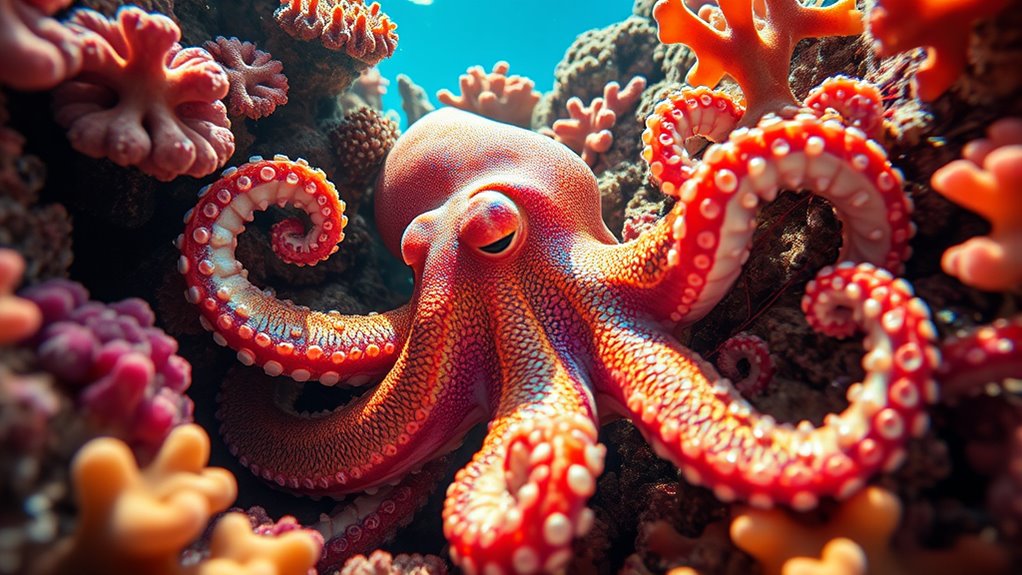
While exploring the fascinating world of octopuses, you'll discover their remarkable ability to change skin color and texture almost instantaneously. This skill allows them to communicate, camouflage, and adapt to their environments. Near-shore species tend to display stronger coloration compared to their open-ocean counterparts. Curiously, octopuses also change their skin color during sleep, hinting at a connection between coloration and behavior.
Here's a quick overview of their coloration features:
| Aspect | Description |
|---|---|
| Color Change Speed | Almost instantaneous |
| Typical Colors | Red, yellow, brown |
| Light Reflection | Iridophores create additional color displays |
| Adaptation | Camouflage, mimicry, signaling |
| Behavior Link | Color changes during sleep cycles |
Chromatophores
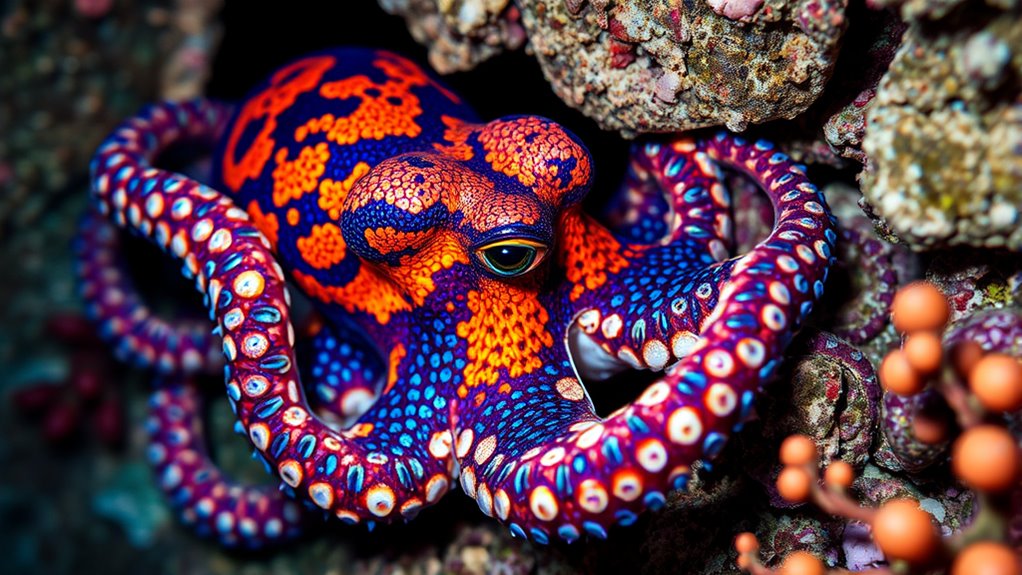
The remarkable pigment cells known as chromatophores play an essential role in an octopus's ability to change color almost instantly.
Chromatophores are extraordinary pigment cells that enable octopuses to change color almost instantaneously.
These cells contain red, yellow, and brown pigments, allowing octopuses to communicate and camouflage effectively. Controlled by neural pathways, chromatophores enable precise color displays in response to environmental cues or social interactions.
Here are three key aspects of chromatophores:
- Rapid Adaptation: Octopuses can alter their skin color and texture within milliseconds, enhancing their survival.
- Evolutionary Significance: Fossils show that chromatophores date back to the Silurian period, highlighting their long evolutionary history.
- Supplementary Cells: Besides chromatophores, iridophores reflect light, creating additional colors to improve blending in various environments.
Locomotion and Buoyancy
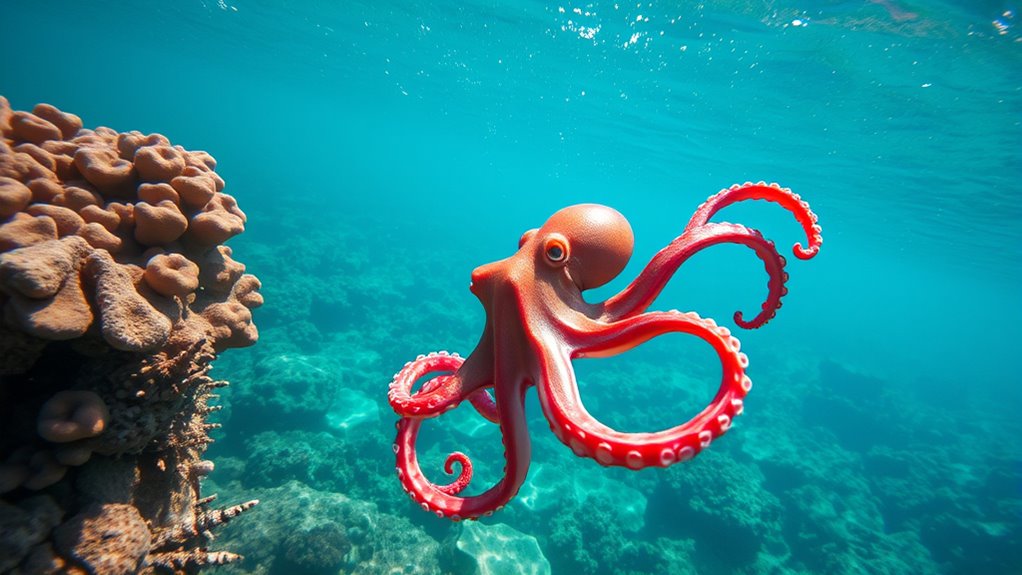
Octopuses excel in their locomotion and buoyancy, utilizing jet propulsion to swiftly navigate the ocean depths. By expelling water through their hyponome, they can outpace most fish.
For larger species, fins and tentacles help maintain steady velocity and improve maneuverability. However, this jet propulsion efficiency decreases with size, making paralarvae more adept at quick movement than adult octopuses.
You'll notice how they expertly control direction by positioning their funnel to direct the expelled water, allowing for agile turns and swift escapes. Additionally, octopuses can produce a popping noise while moving, potentially deterring predators.
This combination of skills makes them exceptional swimmers in various underwater environments.
Reproduction and Life Cycle
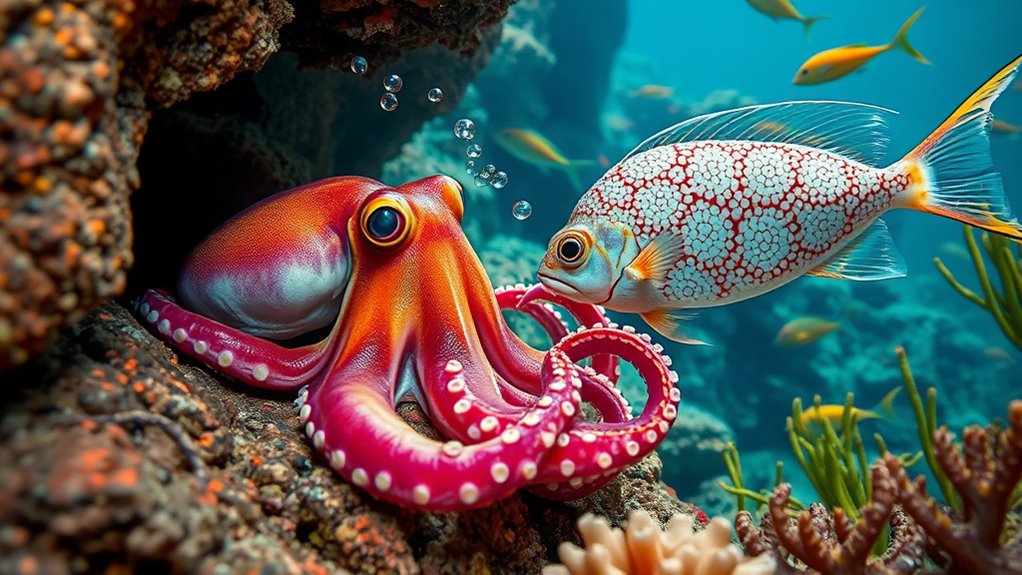
As female octopuses prepare for reproduction, they lay an astonishing number of eggs—between 20,000 and 400,000—demonstrating a remarkable commitment to their offspring.
They guard and clean their eggs until they hatch, but this devotion comes at a cost. After laying, females enter a period of senescence, stop eating, and die shortly after the eggs hatch.
Here are three key points about their life cycle:
- Incubation: The incubation period varies, lasting from a few weeks to several months depending on the species and environment.
- Hatching: Baby octopuses, called paralarvae, are planktonic and drift in ocean currents before settling on the ocean floor.
- Lifespan: Most species live only 1 to 5 years, facing high mortality rates from predation.
Frequently Asked Questions
What Are Curious Facts About Octopuses?
Octopuses are fascinating creatures with some truly curious traits. They can change color and texture almost instantly, thanks to special skin cells.
Their intelligence is impressive, as they can solve problems and manipulate objects effectively. Did you know they can escape from aquariums?
Plus, their jet propulsion allows them to swim faster than most fish. When they sleep, they even show changes in color, hinting at a unique sleep cycle, possibly involving dreams.
What Are the Unique Behaviors of Octopus?
When you explore the unique behaviors of octopuses, you'll discover their incredible problem-solving skills and dexterity, allowing them to escape enclosures.
You might notice how they change color and texture for camouflage or communication. As you observe them, you'll see their arms exploring the environment, packed with sensory neurons.
Some even mimic other marine creatures to avoid danger. Plus, during sleep, their skin shifts, hinting at complex behavioral patterns.
What Is a Playful Behavior of an Octopus?
Did you know that octopuses can have up to 500 million neurons, showcasing their remarkable intelligence?
One playful behavior you might observe is their knack for juggling objects like shells or pebbles. You'd see them tossing these items around, seemingly for fun, which highlights their cognitive complexity.
This playful interaction not only entertains you but also helps octopuses develop essential problem-solving skills, preparing them for hunting in their natural surroundings.
Are Octopuses Curious?
Yes, octopuses are incredibly curious creatures.
You'll find them exploring their surroundings with their dexterous arms, each covered in sensory receptors that help them investigate different objects. They often manipulate toys and engage in play, showcasing their inquisitive nature.
Their curiosity drives them to solve puzzles and escape from enclosures, reflecting their intelligence.
When isolated, they even seek companionship with fish, illustrating their desire to learn and connect with others.
Conclusion
In the world of octopuses, every moment is a dance of color and cunning, much like a master artist at work. With their ability to blend seamlessly into their surroundings, they remind us that adaptability is key in life. Just as an octopus can shift from vibrant hues to muted tones in an instant, you too can navigate challenges with grace and creativity. Embrace the curious habits of these fascinating creatures, and let their lessons inspire your own journey.




